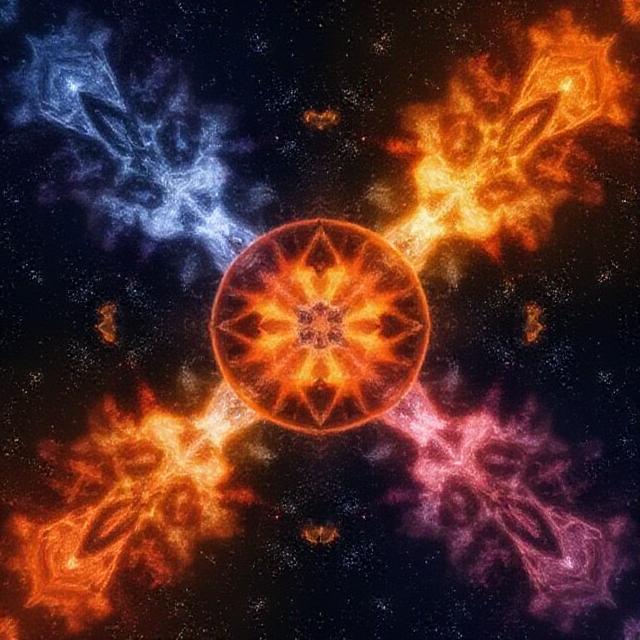The Symmetry Paradox: Why Is the Universe So Perfectly 'Just Right'?

There’s a kind of eerie perfection woven into the fabric of our reality.
The more deeply we peer into the laws of physics, the more we find a haunting pattern: the universe appears to be precisely balanced, finely tuned, and deeply symmetric — in a way that seems almost… intentional.
From the fundamental constants to the invisible scaffolding of galaxies, symmetry appears everywhere. But why? And what breaks it?
Here are some of the deepest, most unresolved mysteries that stem from the universe’s obsession with symmetry — and what it might mean for reality itself.
1. 🧪 The Fine-Tuning Problem: A “Just Right” Universe
Many of the universe’s fundamental properties — from the strength of gravity to the charge of the electron — seem finely tuned for one thing: the existence of complex matter and ultimately, life.
If even one of these values were slightly different, the universe as we know it might not exist at all.
A Few “Coincidences” That Shouldn’t Be:
- Strong nuclear force: Slightly weaker? No atoms beyond hydrogen. Slightly stronger? No hydrogen — the most abundant element in the universe.
- Gravitational constant: A bit stronger? The universe collapses. A bit weaker? Stars and galaxies never form.
- Cosmological constant: Its value is 120 orders of magnitude smaller than theoretical predictions — and yet just right to allow cosmic structures to form.
- Electron-to-proton mass ratio: Essential for stable atoms and chemical reactions.
The universe, it seems, is improbably balanced on a razor’s edge.
So What Explains It?
- Coincidence? The Anthropic Principle says: “Of course the universe seems perfect — if it weren’t, we wouldn’t be here to notice.”
- Multiverse? We might be one of many universes, each with different constants. Most are sterile. Ours got lucky.
- Deeper Physics? Maybe a future “Theory of Everything” will show that these values must be what they are.
- Intelligent Design? Some argue the fine-tuning implies purpose — but that enters the realm of philosophy or theology.
We don’t know the answer. But the precision remains uncomfortably uncanny.
2. 💥 The Matter–Antimatter Asymmetry: Where Did the Mirror Go?
According to the Standard Model of physics, the Big Bang should have created equal parts matter and antimatter.
But if that were true, everything should have annihilated into pure energy. No stars. No galaxies. No us.
And yet… we’re here.
The observable universe is overwhelmingly made of matter, with antimatter being almost nonexistent.
For every billion antimatter particles, there was just one extra matter particle. That tiny surplus became everything.
But Why?
This is the baryogenesis problem — and our current understanding of CP violation doesn’t explain the observed imbalance.
It suggests that some deep symmetry — one that should have balanced matter and antimatter — was broken very early in the universe’s life.
We still don’t know what caused that break — or why.
3. ⚖️ The Constancy of the Constants
Why is Planck’s constant constant?
Why does the speed of light never change — not in deep space, not at the beginning of time?
What We Assume:
Fundamental constants (like h, c, G, e) are assumed to be universal — unchanging across space and time.
Experiments have shown no significant variation across cosmic distances or epochs.
But here’s the unsettling part:
We don’t know why they have the values they do.
They are simply… measured. Not explained.
Some fringe theories — involving extra dimensions or scalar fields — suggest they could vary over immense timescales or distances. If that ever proved true, it would shatter modern physics.
Constancy itself may be a kind of cosmic symmetry. One we assume is eternal — but haven’t truly tested at scale.
4. 🌌 Spontaneous Symmetry Breaking: When Perfection Cracks
In the earliest moments of the universe, physicists believe all forces were unified — the ultimate symmetry.
But as the universe cooled, that symmetry fractured.
The most famous example is the Higgs Mechanism, where the Higgs field “broke” the electroweak symmetry. As a result, particles that were once massless gained mass. Without this break, no atoms, no matter, no life.
From symmetry, came diversity.
These symmetry breakings are the cosmic phase transitions — like water freezing into ice — that sculpted the universe we know.
And yet… we still don’t fully understand them. Why did the Higgs field “choose” the value it did? Could there have been other universes where it broke differently?
5. 🕳️ Dark Matter and Dark Energy: The Invisible Symmetries
What we see — stars, galaxies, nebulae — is only about 5% of the universe.
The rest?
- Dark Matter — doesn’t emit or absorb light. We know it exists from its gravitational effects.
- Dark Energy — a mysterious force pushing the universe to expand faster and faster.
We don’t know what either of them is.
But they may represent entire sectors of the universe governed by new, hidden symmetries. Some physicists theorize “dark forces” and “dark particles” — a shadow Standard Model we haven’t yet glimpsed.
Or… they could be relics of broken symmetries from the early universe, leftovers from physics we haven’t even imagined yet.
95% of the universe is an unsolved equation.
🧠 Final Reflection
Symmetry is everywhere — from snowflakes to galaxies to quantum fields.
But sometimes it breaks.
And when it does, reality happens.
We owe our existence to a universe that is both exquisitely symmetric… and mysteriously flawed.
- Why does it favor matter over antimatter?
- Why does it hold to a few constants, but fracture into complexity?
- Why is it just right for consciousness to emerge and wonder why?
We are the result of a cosmic balance — and perhaps, a cosmic imbalance.
And until we know why the universe is written the way it is…
Every answer will only lead to a deeper, stranger question.
More Cosmic Wonders

The Universe Where Past, Present, and Future All Exist at Once
If your birth, life, and death already exist in the fabric of the cosmos, what does that mean for free will? Explore the eerie Block Universe theory and the science behind it.

Beyond Belief: 10 Space Facts That Shatter Your Reality
Space is weirder than science fiction. Here are 10 space facts that sound fake—but are completely real.

The Silence in the Stars: 6 Chilling Possibilities Behind the Fermi Paradox
If intelligent life should be common in the universe, why haven’t we seen any signs of it? From cosmic filters to simulation theory, here are the most haunting answers to the Fermi Paradox.
